Evaluation of the Solar Energy Nowcasting System (SENSE) during a 12-Months Intensive Measurement Campaign in Athens, Greece
Abstract
1. Introduction
2. Data and Tools
2.1. SENSE
2.2. Ground Based Data
2.2.1. Solar Radiation Measurements
2.2.2. Sky Images—Cloud Related Measurements
2.2.3. Total Column Spectral Aerosol Optical Properties and Water Vapor
2.3. Comparison Statistics
3. Results
3.1. Comparison Overview
3.2. Investigation of SENSE Accuracy and Limitations
3.2.1. Comparison between Synchronous SENSE and Measurement Data
3.2.2. Assessment of Differences
- a.
- Overall differences
- b.
- aerosol effect
- c.
- water vapor effect
- d.
- cloud effects
4. Conclusions
Author Contributions
Funding
Data Availability Statement
Acknowledgments
Conflicts of Interest
References
- Malm, A. Fossil Capital: The Rise of Steam-Power and the Roots of Global Warming; Verso: London, UK, 2016; ISBN 978-1-78478-129-3. [Google Scholar]
- Kåberger, T. Progress of renewable electricity replacing fossil fuels. Glob. Energy Interconnect. 2018, 1, 48–52. [Google Scholar] [CrossRef]
- Shukla, P.R.; Skea, J.; Calvo Buendia, E.; Masson-Delmotte, V.; Pörtner, H.-O.; Roberts, D.; Zhai, P.; Slade, R.; Connors, S.; Van Diemen, R.; et al. IPCC, 2019: Climate Change and Land: An IPCC Special Report on Climate Change, Desertification, Land Degradation, Sustainable Land Management, Food Security, and Greenhouse Gas Fluxes in Terrestrial Ecosystems; Imperial College: London, UK, 2019. [Google Scholar]
- International Renewable Energy Agency (IRENA). Renewable Power Generation Costs in 2019; IRENA: Abu Dhabi, United Arab Emirates, 2020. [Google Scholar]
- REN21. Renewables 2023 Global Status Report collection, Renewables in Energy Demand; REN21 Secreatariat: Paris, France, 2023; ISBN 978-3-948393-07-6. [Google Scholar]
- IEA. Renewables 2019; IEA: Paris, France, 2019. [Google Scholar]
- Mulder, F.M. Implications of diurnal and seasonal variations in renewable energy generation for large scale energy storage. J. Renew. Sustain. Energy 2014, 6, 033105. [Google Scholar] [CrossRef]
- Kan, A.; Zeng, Y.; Meng, X.; Wang, D.; Xina, J.; Yang, X.; Tesren, L. The linkage between renewable energy potential and sustainable development: Understanding solar energy variability and photovoltaic power potential in Tibet, China. Sustain. Energy Technol. Assess. 2021, 48, 101551. [Google Scholar] [CrossRef]
- Denholm, P.; Brown, P.; Cole, W.; Mai, T.; Sergi, B.; Brown, M.; Jadun, P.; Ho, J.; Mayernik, J.; McMillan, C.; et al. Examining Supply-Side Options to Achieve 100% Clean Electricity by 2035; USDOE: Washington, DC, USA, 2022. [Google Scholar]
- Obiora, C.N.; Ali, A.; Hasan, A.N. Estimation of Hourly Global Solar Radiation Using Deep Learning Algorithms. In Proceedings of the 2020 11th International Renewable Energy Congress (IREC), Hammamet, Tunisia, 29–31 October 2020; IEEE: Hammamet, Tunisia, 2020; pp. 1–6. [Google Scholar]
- Voyant, C.; Motte, F.; Notton, G.; Fouilloy, A.; Nivet, M.-L.; Duchaud, J.-L. Prediction intervals for global solar irradiation forecasting using regression trees methods. Renew. Energy 2018, 126, 332–340. [Google Scholar] [CrossRef]
- Ayet, A.; Tandeo, P. Nowcasting solar irradiance using an analog method and geostationary satellite images. Sol. Energy 2018, 164, 301–315. [Google Scholar] [CrossRef]
- Juncklaus Martins, B.; Cerentini, A.; Mantelli, S.L.; Loureiro Chaves, T.Z.; Moreira Branco, N.; von Wangenheim, A.; Rüther, R.; Marian Arrais, J. Systematic review of nowcasting approaches for solar energy production based upon ground-based cloud imaging. Sol. Energy Adv. 2022, 2, 100019. [Google Scholar] [CrossRef]
- Ravi Kumar, K.; Krishna Chaitanya, N.V.V.; Sendhil Kumar, N. Solar thermal energy technologies and its applications for process heating and power generation—A review. J. Clean. Prod. 2021, 282, 125296. [Google Scholar] [CrossRef]
- Yang, D.; Wu, E.; Kleissl, J. Operational solar forecasting for the real-time market. Int. J. Forecast. 2019, 35, 1499–1519. [Google Scholar] [CrossRef]
- Krishnan, N.; Kumar, K.R.; Inda, C.S. How solar radiation forecasting impacts the utilization of solar energy: A critical review. J. Clean. Prod. 2023, 388, 135860. [Google Scholar] [CrossRef]
- Catalina, A.; Alaiz, C.M.; Dorronsoro, J.R. Combining Numerical Weather Predictions and Satellite Data for PV Energy Nowcasting. IEEE Trans. Sustain. Energy 2020, 11, 1930–1937. [Google Scholar] [CrossRef]
- Bright, J.M. Solcast: Validation of a satellite-derived solar irradiance dataset. Sol. Energy 2019, 189, 435–449. [Google Scholar] [CrossRef]
- Yang, D.; Bright, J.M. Worldwide validation of 8 satellite-derived and reanalysis solar radiation products: A preliminary evaluation and overall metrics for hourly data over 27 years. Sol. Energy 2020, 210, 3–19. [Google Scholar] [CrossRef]
- Kosmopoulos, P.G.; Kazadzis, S.; Taylor, M.; Raptis, P.I.; Keramitsoglou, I.; Kiranoudis, C.; Bais, A.F. Assessment of surface solar irradiance derived from real-time modelling techniques and verification with ground-based measurements. Atmos. Meas. Technol. 2018, 11, 907–924. [Google Scholar] [CrossRef]
- Kosmopoulos, P.; Kouroutsidis, D.; Papachristopoulou, K.; Raptis, P.I.; Masoom, A.; Saint-Drenan, Y.-M.; Blanc, P.; Kontoes, C.; Kazadzis, S. Short-Term Forecasting of Large-Scale Clouds Impact on Downwelling Surface Solar Irradiation. Energies 2020, 13, 6555. [Google Scholar] [CrossRef]
- Huld, T.; Müller, R.; Gambardella, A. A new solar radiation database for estimating PV performance in Europe and Africa. Sol. Energy 2012, 86, 1803–1815. [Google Scholar] [CrossRef]
- Wang, F.; Mi, Z.; Su, S.; Zhao, H. Short-Term Solar Irradiance Forecasting Model Based on Artificial Neural Network Using Statistical Feature Parameters. Energies 2012, 5, 1355–1370. [Google Scholar] [CrossRef]
- Masoom, A.; Kosmopoulos, P.; Bansal, A.; Gkikas, A.; Proestakis, E.; Kazadzis, S.; Amiridis, V. Forecasting dust impact on solar energy using remote sensing and modeling techniques. Sol. Energy 2021, 228, 317–332. [Google Scholar] [CrossRef]
- Papachristopoulou, K.; Fountoulakis, I.; Bais, A.F.; Psiloglou, B.E.; Papadimitriou, N.; Raptis, I.-P.; Kazantzidis, A.; Kontoes, C.; Hatzaki, M.; Kazadzis, S. Effects of clouds and aerosols on downwelling surface solar irradiance nowcasting and sort-term forecasting. Atmos. Meas. Tech. Discuss. 2023. [Google Scholar] [CrossRef]
- Raptis, I.-P.; Kazadzis, S.; Amiridis, V.; Gkikas, A.; Gerasopoulos, E.; Mihalopoulos, N. A Decade of Aerosol Optical Properties Measurements over Athens, Greece. Atmosphere 2020, 11, 154. [Google Scholar] [CrossRef]
- Gröbner, J.; Kouremeti, N. The Precision Solar Spectroradiometer (PSR) for direct solar irradiance measurements. Sol. Energy 2019, 185, 199–210. [Google Scholar] [CrossRef]
- Raptis, P.-I.; Kazadzis, S.; Gröbner, J.; Kouremeti, N.; Doppler, L.; Becker, R.; Helmis, C. Water vapour retrieval using the Precision Solar Spectroradiometer. Atmos. Meas. Techol. 2018, 11, 1143–1157. [Google Scholar] [CrossRef]
- Gröbner, J.; Kouremeti, N.; Hülsen, G.; Zuber, R.; Ribnitzky, M.; Nevas, S.; Sperfeld, P.; Schwind, K.; Schneider, P.; Kazadzis, S.; et al. Spectral Aerosol Optical Depth from Traceable Spectral Solar Irradiance Measurements to the SI; Aerosols/Remote Sensing/Validation and Intercomparisons; EGUsphere: Vienna, Austria, 2023. [Google Scholar]
- Hulstrom, R. Solar Resources; MIT Press: Cambridge, MA, USA, 2002. [Google Scholar]
- Gueymard, C.; Vignola, F. Determination of atmospheric turbidity from the diffuse-beam broadband irradiance ratio. Sol. Energy 1998, 63, 135–146. [Google Scholar] [CrossRef]
- Kazantzidis, A.; Tzoumanikas, P.; Bais, A.F.; Fotopoulos, S.; Economou, G. Cloud detection and classification with the use of whole-sky ground-based images. Atmos. Res. 2012, 113, 80–88. [Google Scholar] [CrossRef]
- Tzoumanikas, P.; Nikitidou, E.; Bais, A.F.; Kazantzidis, A. The effect of clouds on surface solar irradiance, based on data from an all-sky imaging system. Renew. Energy 2016, 95, 314–322. [Google Scholar] [CrossRef]
- Hasenbalg, M.; Kuhn, P.; Wilbert, S.; Nouri, B.; Kazantzidis, A. Benchmarking of six cloud segmentation algorithms for ground-based all-sky imagers. Sol. Energy 2020, 201, 596–614. [Google Scholar] [CrossRef]
- Tsourounis, D.; Kastaniotis, D.; Theoharatos, C.; Kazantzidis, A.; Economou, G. SIFT-CNN: When Convolutional Neural Networks Meet Dense SIFT Descriptors for Image and Sequence Classification. J. Imaging 2022, 8, 256. [Google Scholar] [CrossRef]
- Holben, B.N.; Eck, T.F.; Slutsker, I.; Tanré, D.; Buis, J.P.; Setzer, A.; Vermote, E.; Reagan, J.A.; Kaufman, Y.J.; Nakajima, T.; et al. AERONET—A Federated Instrument Network and Data Archive for Aerosol Characterization. Remote Sens. Environ. 1998, 66, 1–16. [Google Scholar] [CrossRef]
- Giles, D.M.; Sinyuk, A.; Sorokin, M.G.; Schafer, J.S.; Smirnov, A.; Slutsker, I.; Eck, T.F.; Holben, B.N.; Lewis, J.R.; Campbell, J.R.; et al. Advancements in the Aerosol Robotic Network (AERONET) Version 3 database—automated near-real-time quality control algorithm with improved cloud screening for Sun photometer aerosol optical depth (AOD) measurements. Atmos. Meas. Technol. 2019, 12, 169–209. [Google Scholar] [CrossRef]
- Smirnov, A.; Holben, B.N.; Eck, T.F.; Slutsker, I.; Chatenet, B.; Pinker, R.T. Diurnal variability of aerosol optical depth observed at AERONET (Aerosol Robotic Network) sites: Aerosol optical depth diurnal variability. Geophys. Res. Lett. 2002, 29, 30-1–30-34. [Google Scholar] [CrossRef]
- Carlton, A.G.; Turpin, B.J.; Altieri, K.E.; Seitzinger, S.; Reff, A.; Lim, H.-J.; Ervens, B. Atmospheric oxalic acid and SOA production from glyoxal: Results of aqueous photooxidation experiments. Atmos. Environ. 2007, 41, 7588–7602. [Google Scholar] [CrossRef]
- Molina, L.T.; Madronich, S.; Gaffney, J.S.; Apel, E.; de Foy, B.; Fast, J.; Ferrare, R.; Herndon, S.; Jimenez, J.L.; Lamb, B.; et al. An overview of the MILAGRO 2006 Campaign: Mexico City emissions and their transport and transformation. Atmos. Chem. Phys. 2010, 10, 8697–8760. [Google Scholar] [CrossRef]
- Shahid, I.; Shahid, M.Z.; Chen, Z.; Asif, Z. Long-Term Variability of Aerosol Concentrations and Optical Properties over the Indo-Gangetic Plain in South Asia. Atmosphere 2022, 13, 1266. [Google Scholar] [CrossRef]
- Zeng, L.; Huang, D.D.; Zhu, S.; Li, F.; Zhou, M.; Qiao, L.; Wang, Q.; Wang, Q.; Ma, Y.; Lou, S.; et al. The interplays among meteorology, source, and chemistry in high particulate matter pollution episodes in urban Shanghai, China. Sci. Total Environ. 2022, 853, 158347. [Google Scholar] [CrossRef] [PubMed]
- Gueymard, C.A.; Yang, D. Worldwide validation of CAMS and MERRA-2 reanalysis aerosol optical depth products using 15 years of AERONET observations. Atmos. Environ. 2020, 225, 117216. [Google Scholar] [CrossRef]
- Masoom, A.; Fountoulakis, I.; Kazadzis, S.; Raptis, I.-P.; Kampouri, A.; Psiloglou, B.; Kouklaki, D.; Papachristopoulou, K.; Marinou, E.; Solomos, S.; et al. Investigation of the Effects of the Greek Extreme Wildfires of August 2021 on Air Quality and Spectral Solar Irradiance; Aerosols/Field Measurements/Troposphere/Physics (Physical Properties and Processes); EGUsphere: Vienna, Austria, 2023. [Google Scholar]
- Kosmopoulos, P.G.; Kazadzis, S.; Taylor, M.; Athanasopoulou, E.; Speyer, O.; Raptis, P.I.; Marinou, E.; Proestakis, E.; Solomos, S.; Gerasopoulos, E.; et al. Dust impact on surface solar irradiance assessed with model simulations, satellite observations and ground-based measurements. Atmos. Meas. Technol. 2017, 10, 2435–2453. [Google Scholar] [CrossRef]
- Gueymard, C.A. Impact of on-site atmospheric water vapor estimation methods on the accuracy of local solar irradiance predictions. Sol. Energy 2014, 101, 74–82. [Google Scholar] [CrossRef]
- Salamalikis, V.; Vamvakas, I.; Gueymard, C.A.; Kazantzidis, A. Atmospheric water vapor radiative effects on shortwave radiation under clear skies: A global spatiotemporal analysis. Atmos. Res. 2021, 251, 105418. [Google Scholar] [CrossRef]
- Kazadzis, S.; Bais, A.; Balis, D.; Kouremeti, N.; Zempila, M.; Arola, A.; Giannakaki, E.; Amiridis, V.; Kazantzidis, A. Spatial and temporal UV irradiance and aerosol variability within the area of an OMI satellite pixel. Atmos. Chem. Phys. 2009, 9, 4593–4601. [Google Scholar] [CrossRef]
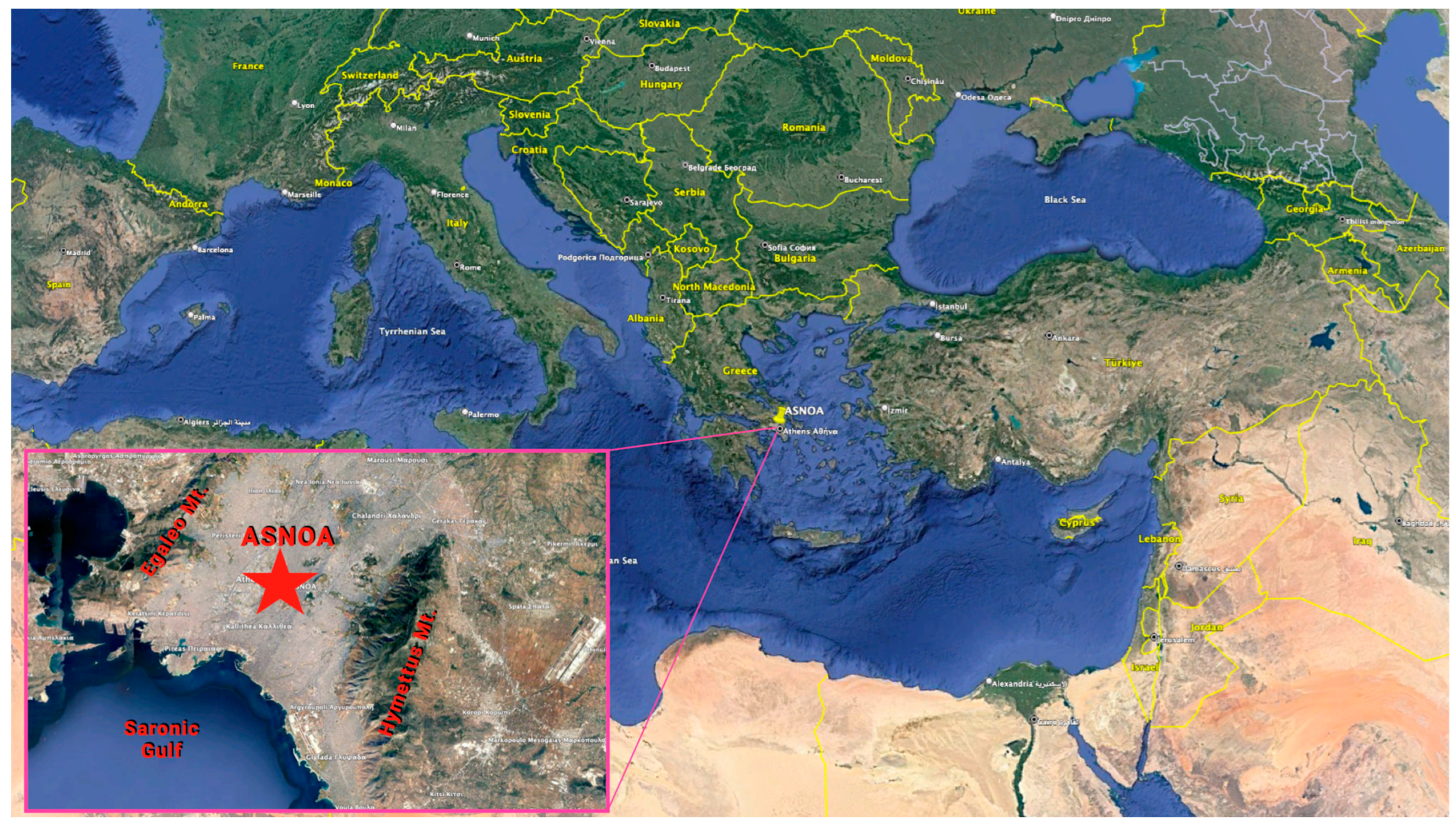

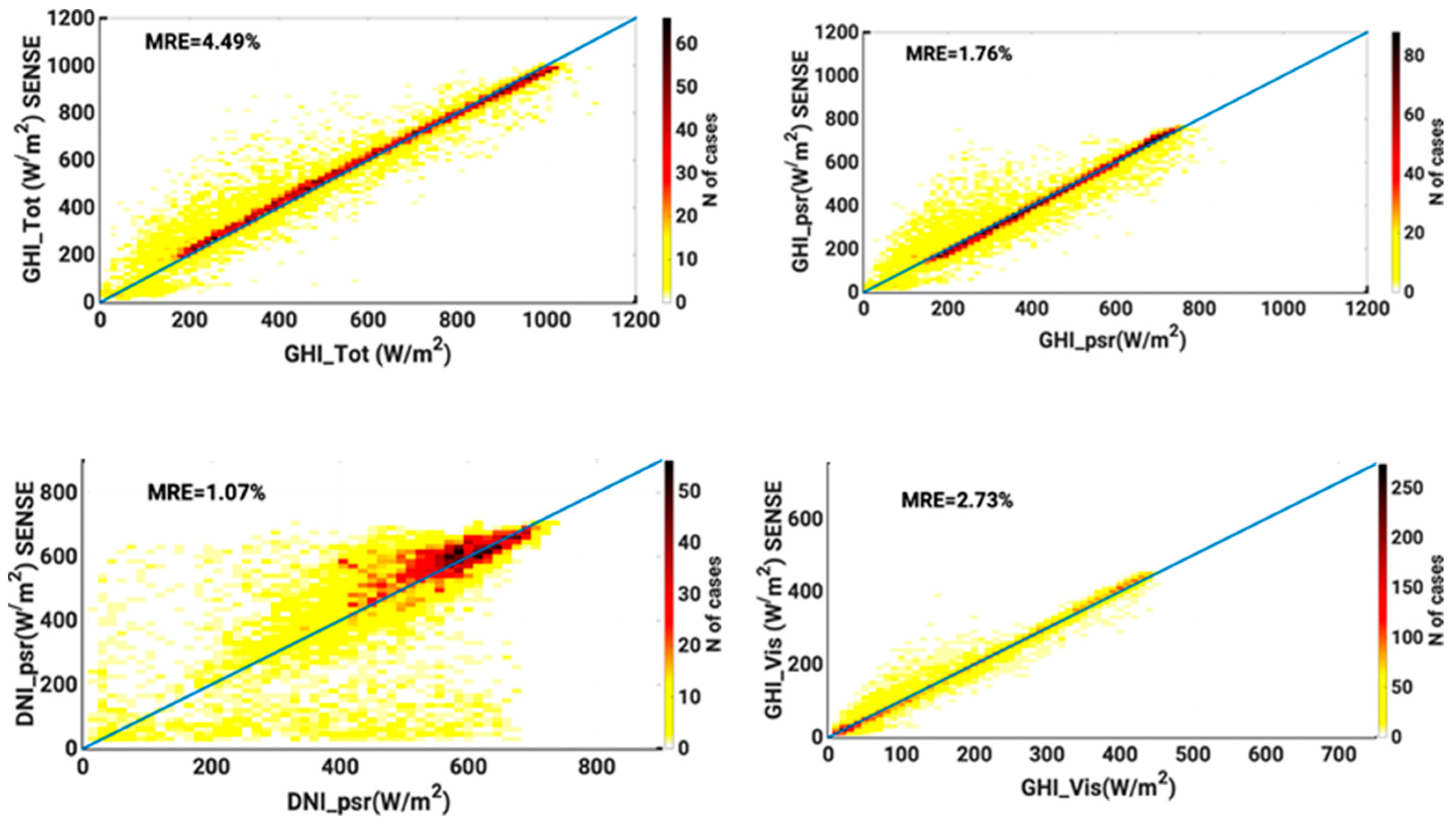
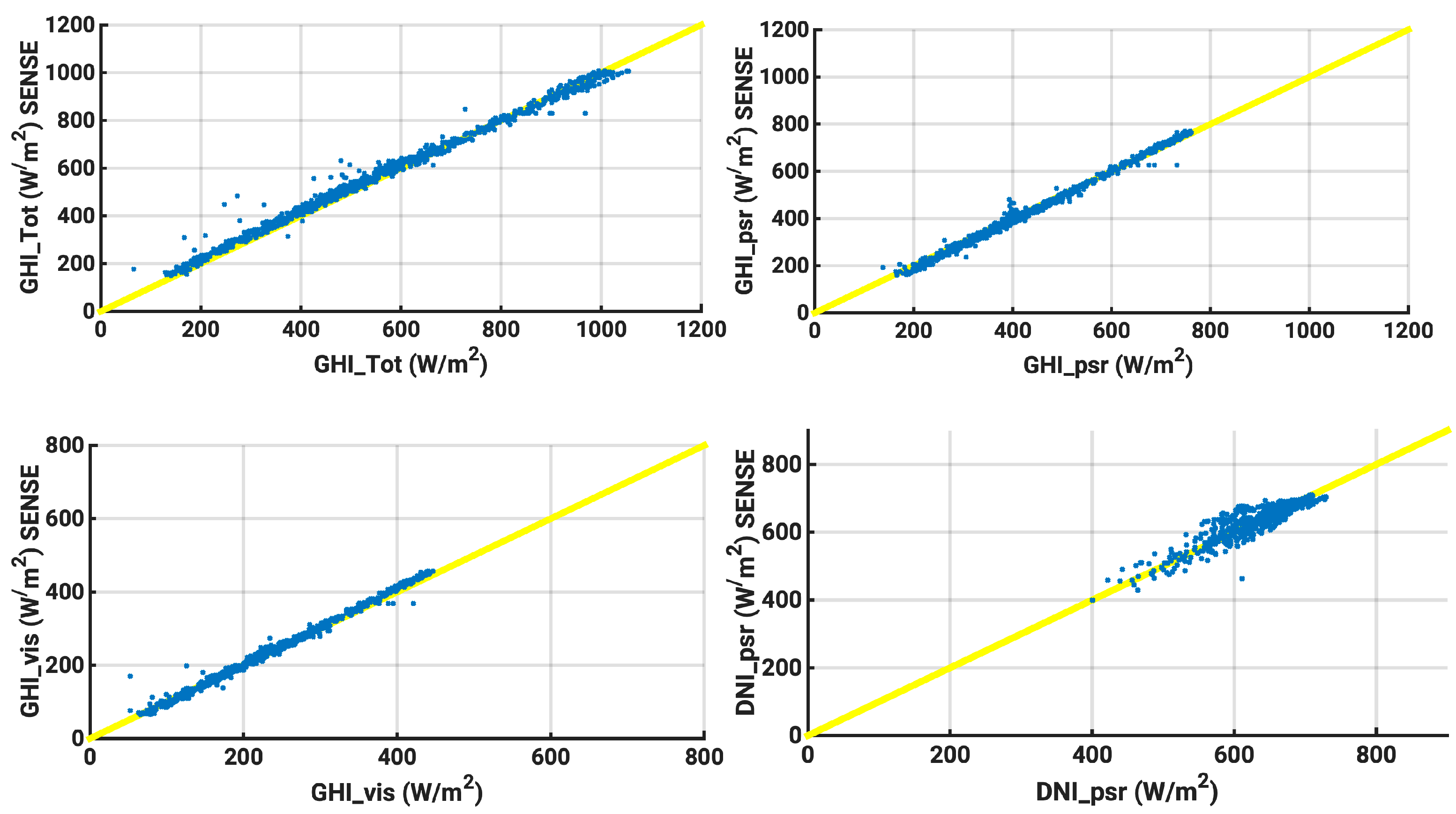


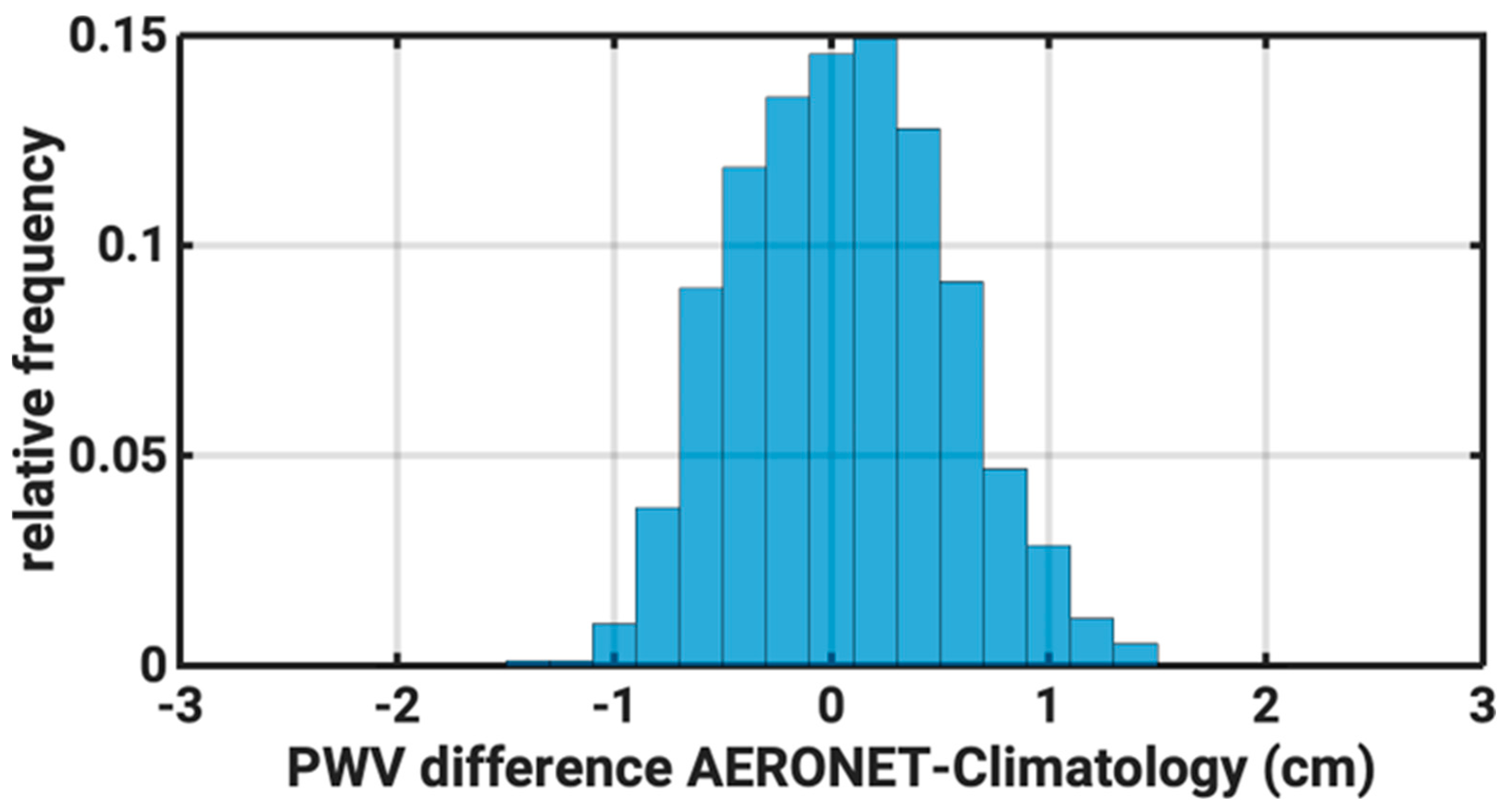

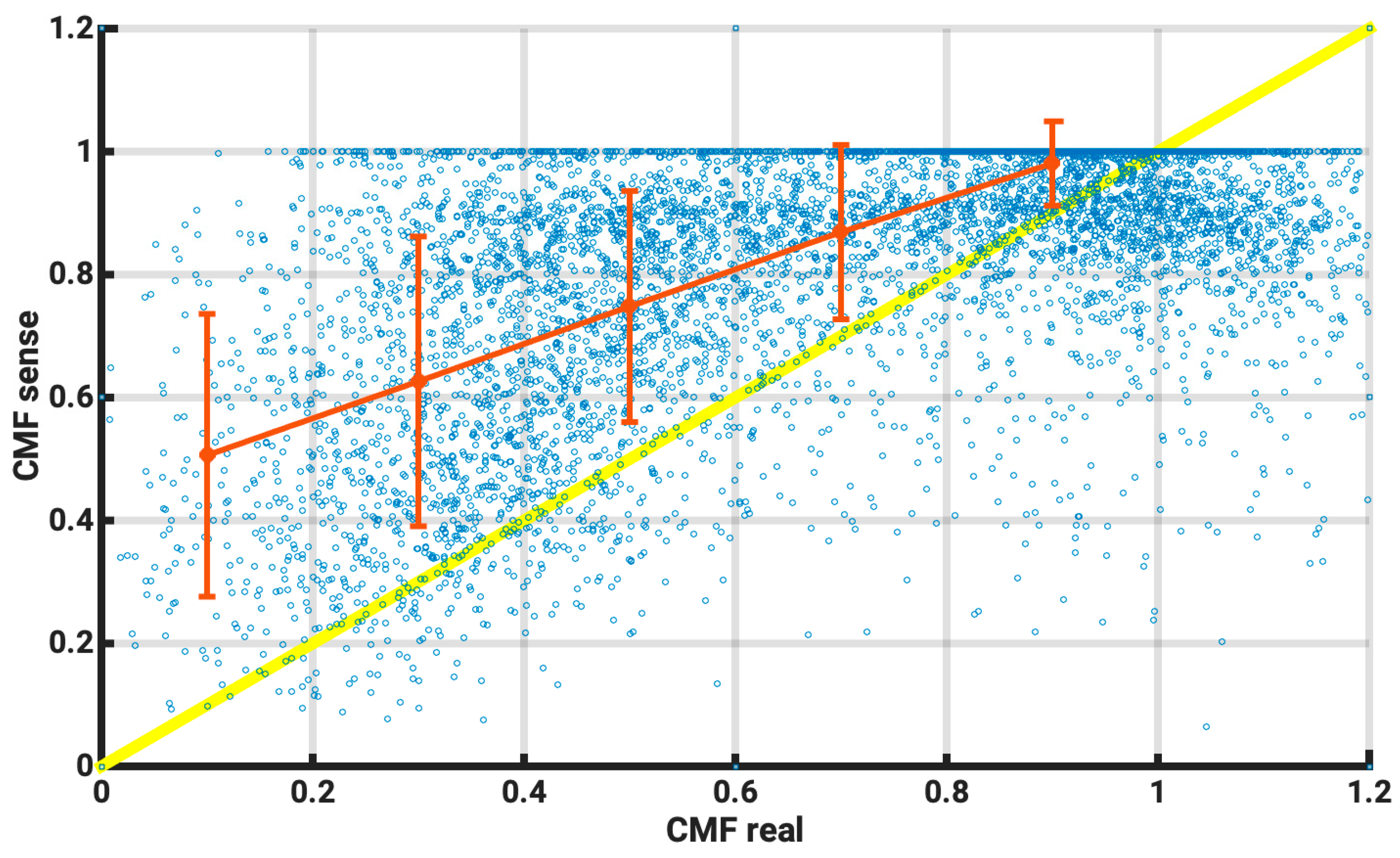


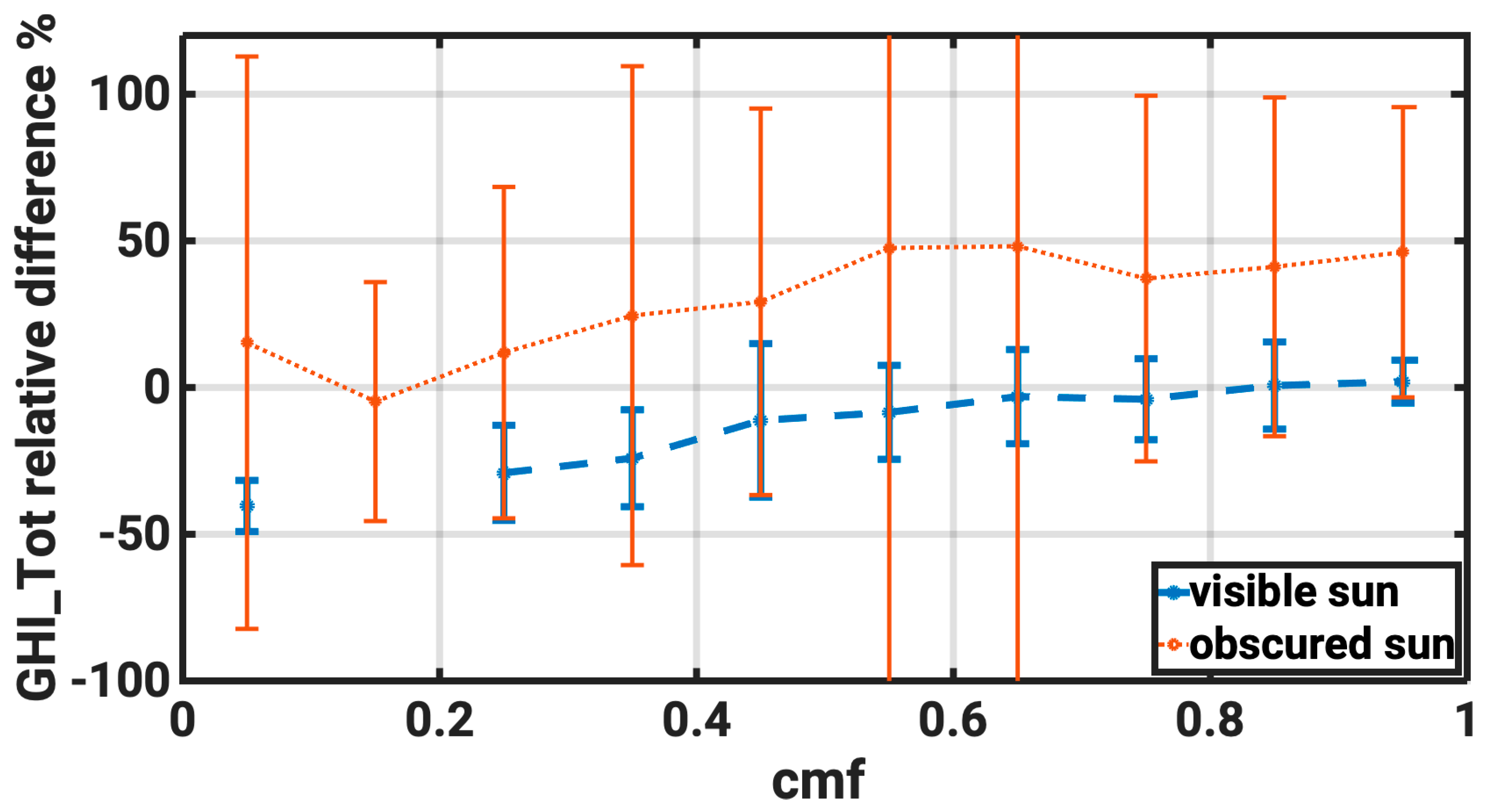
| Parameter | Source |
|---|---|
| Solar Zenith Angle | Calculated—15 min |
| Aerosol optical depth at 550 nm (AOD) | CAMS forecast from the previous day—1 h |
| Single Scattering Albedo (SSA) | Monthly Climatology |
| Angstrom exponent (AE) | |
| Water Vapor (WV in cm) | |
| Total Ozone Column (TOC in DU) | TEMIS daily forecast |
| Surface albedo | 0.2 |
| Cloud optical thickness (COT) | MSG data from EUMETSAT NWC SAF |
| GHI_tot | GHI_psr | GHI_vis | DNI_tot | DNI_psr | |
|---|---|---|---|---|---|
| Spectral range | 285–2800 nm | 300–1020 nm | 400–700 nm | 200–4000 nm | 300–1020 nm |
| name | Pyranometer Eppley PSP | PSR | PSR | Pyrheliometer CHP1 | PSR |
| frequency | 1 min | ~4 min | ~4 min | 1 min | ~4 min |
| GHI_tot | GHI_psr | GHI_vis | DNI_tot | DNI_psr | ||
|---|---|---|---|---|---|---|
| Instant (W/m2) | MBE | 21.0 | 3.3 | 2.6 | −2.0 | 0.3 |
| (σ) | (38.1) | (33.3) | (14.3) | (75.4) | (49.3) | |
| MRE | 4.5% | 1.8% | 2.7% | 2.4% | 1.0% | |
| RMSE | 56.2 | 42.1 | 22.4 | 99.1 | 62.4 | |
| R2 | 0.94 | 0.91 | 0.94 | 0.66 | 0.79 | |
| Hourly (W/m2) | MBE | 17.0 | 0.4 | 2.4 | −5.5 | 0.4 |
| (σ) | (28.4) | (18.4) | (9.8) | (61.2) | (36.7) | |
| MRE | 2.1% | 0.7% | 0.4% | 0.9% | 0.4% | |
| RMSE | 40.8 | 24.8 | 14.5 | 75.1 | 56.3 | |
| R2 | 0.96 | 0.96 | 0.96 | 0.76 | 0.80 | |
| Daily (kWh/m2) | MBE | −0.5 | 0.1 | 0.2 | −0.9 | 0.1 |
| (σ) | (0.7) | (0.4) | (0.4) | (2.1) | (1.3) | |
| MRE | 0.3% | 0.2% | 0.5% | 1.5% | 0.3% | |
| RMSE | 0.6 | 0.4 | 0.3 | 0.99 | 0.81 | |
| R2 | 0.99 | 0.99 | 0.99 | 0.95 | 0.91 |
| GHI_tot | GHI_psr | GHI_vis | DNI_tot | DNI_psr | |
|---|---|---|---|---|---|
| MBE | 6.1 | −1.9 | 1.4 | 39.6 | 1.2 |
| RMSE | 15.3 | 7.5 | 4.9 | 43.6 | 13.2 |
| R2 | 0.99 | 0.99 | 0.99 | 0.92 | 0.90 |
| MRE (%) | 1.9 | −0.9 | 1.0 | 5.0 | 0.45 |
| ΜΒΕ | RMSE | R2 | MRE (%) | N of Data | |
|---|---|---|---|---|---|
| A (sun/high CMF) | 4.4 | 9.1 | 0.99 | 1.4 | 10,680 |
| B (sun/low CMF) | −189.4 | 225.2 | 0.51 | −21.1 | 197 |
| C (no sun/high CMF) | 145.8 | 212.6 | 0.55 | 42.9 | 2165 |
| D (no sun/low CMF) | 7.8 | 17.5 | 0.98 | 19.7 | 1177 |
Disclaimer/Publisher’s Note: The statements, opinions and data contained in all publications are solely those of the individual author(s) and contributor(s) and not of MDPI and/or the editor(s). MDPI and/or the editor(s) disclaim responsibility for any injury to people or property resulting from any ideas, methods, instructions or products referred to in the content. |
© 2023 by the authors. Licensee MDPI, Basel, Switzerland. This article is an open access article distributed under the terms and conditions of the Creative Commons Attribution (CC BY) license (https://creativecommons.org/licenses/by/4.0/).
Share and Cite
Raptis, I.-P.; Kazadzis, S.; Fountoulakis, I.; Papachristopoulou, K.; Kouklaki, D.; Psiloglou, B.E.; Kazantzidis, A.; Benetatos, C.; Papadimitriou, N.; Eleftheratos, K. Evaluation of the Solar Energy Nowcasting System (SENSE) during a 12-Months Intensive Measurement Campaign in Athens, Greece. Energies 2023, 16, 5361. https://doi.org/10.3390/en16145361
Raptis I-P, Kazadzis S, Fountoulakis I, Papachristopoulou K, Kouklaki D, Psiloglou BE, Kazantzidis A, Benetatos C, Papadimitriou N, Eleftheratos K. Evaluation of the Solar Energy Nowcasting System (SENSE) during a 12-Months Intensive Measurement Campaign in Athens, Greece. Energies. 2023; 16(14):5361. https://doi.org/10.3390/en16145361
Chicago/Turabian StyleRaptis, Ioannis-Panagiotis, Stelios Kazadzis, Ilias Fountoulakis, Kyriakoula Papachristopoulou, Dimitra Kouklaki, Basil E. Psiloglou, Andreas Kazantzidis, Charilaos Benetatos, Nikolaos Papadimitriou, and Kostas Eleftheratos. 2023. "Evaluation of the Solar Energy Nowcasting System (SENSE) during a 12-Months Intensive Measurement Campaign in Athens, Greece" Energies 16, no. 14: 5361. https://doi.org/10.3390/en16145361
APA StyleRaptis, I.-P., Kazadzis, S., Fountoulakis, I., Papachristopoulou, K., Kouklaki, D., Psiloglou, B. E., Kazantzidis, A., Benetatos, C., Papadimitriou, N., & Eleftheratos, K. (2023). Evaluation of the Solar Energy Nowcasting System (SENSE) during a 12-Months Intensive Measurement Campaign in Athens, Greece. Energies, 16(14), 5361. https://doi.org/10.3390/en16145361












